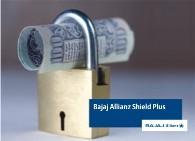 On scrutiny, Shield Plus has no special advantage over a fixed deposit.
On scrutiny, Shield Plus has no special advantage over a fixed deposit.
Bajaj Allianz's new television advertisement has a busful of commuters sniggering at a man who asks his wife if she has invested money in a fixed deposit. The punchline follows: "Why invest in a fixed deposit (FD) when you can get life insurance with 170 per cent guaranteed price and safety." The product in question: Shield Plus.
WHAT IS SHIELD PLUS?
Shield Plus is a fixed term, 10-year, single premium, unit-linked insurance plan (Ulip) that gives a choice of six fund options. Quite like, most other products in the same genre. The main difference here is that this plan also has a fund called Shield Plus-I, which offers a guaranteed minimum unit price on maturity. The sum assured can be 1.1 or five times the single premium paid.
Like most single premium Ulips, the premium paid is invested in funds of your choice and units are allocated depending on the unit price of the fund. The value of your policy is the total value of units you hold in the fund.
THE BASICS
Shield Plus is open for those between 8 and 65 years of age. On maturity, the fund value will be paid as on that date. However, the minimum unit price at maturity (for 10 years) is guaranteed to be a minimum of 170 per cent of the amount invested, as on the date of allocation of units under the policy. On the other hand, the death benefit will be the higher of the sum assured or single premium fund value. Here the death benefit is calculated in a different way. It is based on whether the policyholder expires before 60 years or on reaching 60 years or after that.
Since the product has been compared with an FD in the advertisement, let us carry out the exercise and see how it fares. For starters, except for Shield Plus Fund-I , the other five funds in the policy do not guarantee any returns.
An illustration, which gives the actual returns, can explain this better. Taking the example of a 30 year-old male, (see table) it can be observed that the net yield on the guaranteed maturity value (GMV) at gross yields of 6 per cent and 10 per cent is around 3.47 per cent and 3.72 per cent a year, respectively.
This is extremely low when you compare it to any FD. Even if you are in the highest tax bracket, an absolute return of 7 per cent (from an FD) will yield 4.9 per cent post-tax returns.
On the other hand, the minimum return guaranteed in Shield Plus Fund-I is between 3.47-3.72 per cent. The reason behind the low return is expenses.
POLICY CHARGES
Even though this is a single-premium product, there is an annual 2 per cent policy administration charge for the first five years, followed by a 1.15 per cent charge every year. Besides the policy administration charge , there is a one-time premium allocation charge of 1-1.5 per cent, depending upon the premium amount, a mortality rate for the life insurance cover and a fund management charge of between 0.95-1.35 per cent; a year. Surrender charges in the fourth and fifth year are 6 per cent and 3 per cent, respectively. There is no surrender charge after five years. Partial withdrawals are possible after three years without attracting any charges.
Overall, there isn't a strong reason to select this product over an FD. Basically, Ulips and FDs fall in completely different categories and comparing them would be like comparing an apple to an orange. If you must invest in an FD, do so by all means, without any fear of being laughed at.
The writer is director, My Financial Advisor.





